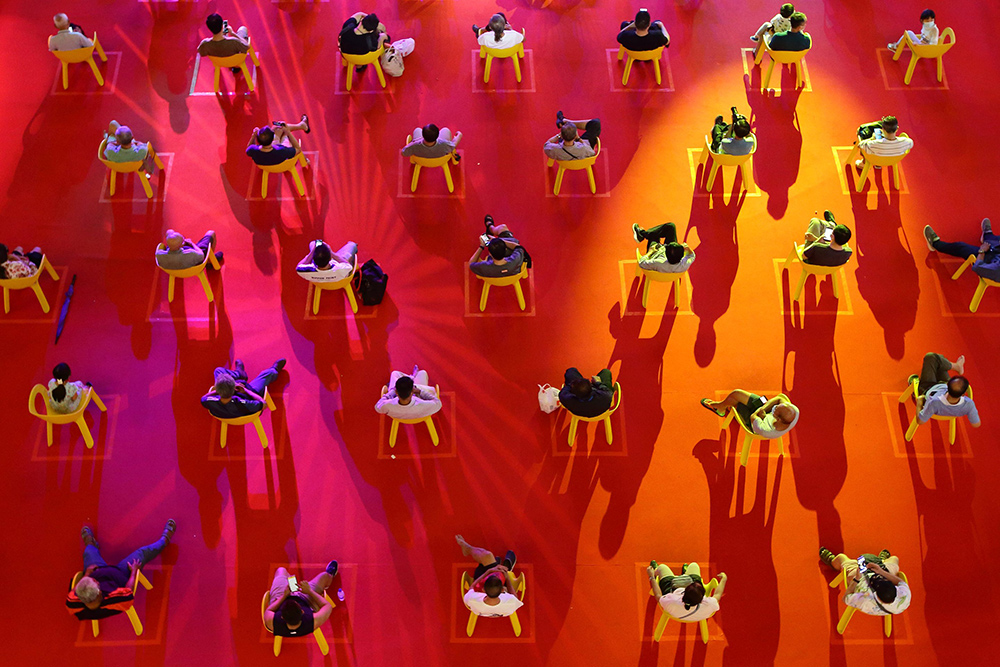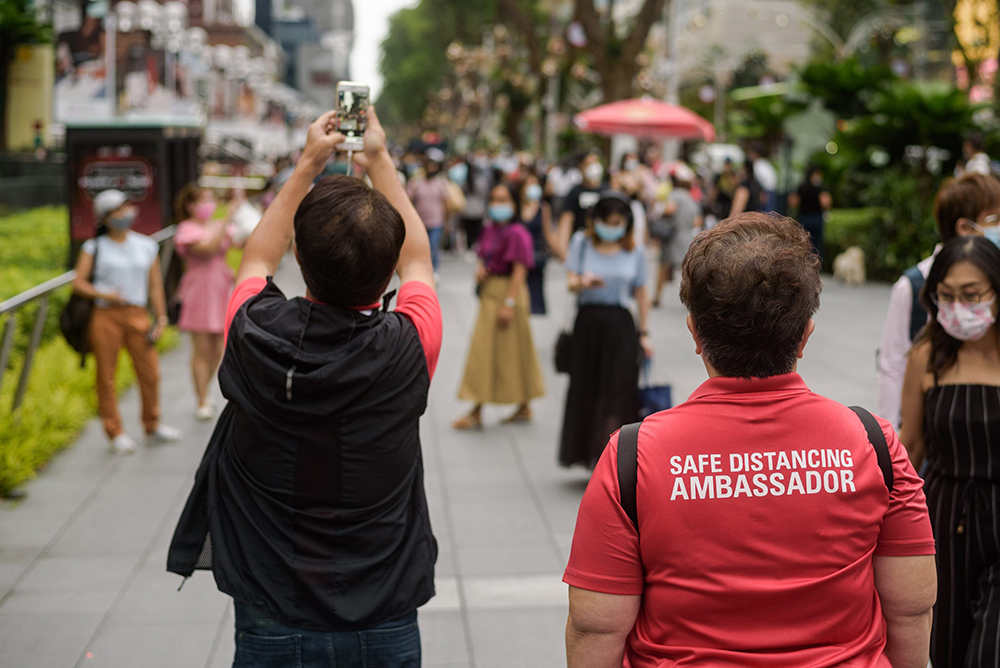2021年8月,,新加坡成為全球首個放棄“清零政策”,、轉(zhuǎn)而選擇“與病毒共存”的國家。但為了與病毒“共存”,,該國國民只得生活在極度警惕的狀態(tài)之中,。
在新冠疫情爆發(fā)18個月后,新加坡政府首次放開入境隔離要求,,一開始只有兩個國家可以享受這種待遇,,截至2021年12月,這一數(shù)字已經(jīng)增加到24個,,不過需要注意的是,,并非所有從上述24個國家起飛的航班均無需進(jìn)行檢疫隔離。與此同時,,該國國內(nèi)依然執(zhí)行著部分管制措施,。無論身處室內(nèi)還是室外,新加坡民眾都必須佩戴口罩,,無論前往何處,,都必須使用接觸追蹤技術(shù)(采集位置信息),并且不能舉行超過5個人的聚會,。政府的確放寬了部分新冠管控政策,,但在日常生活中依然能夠感受這些政策的影響。
如今,新加坡的國內(nèi)疫情正在失控邊緣徘徊,。2021年12月初,,該國發(fā)現(xiàn)了首例奧密克戎變異毒株病例,此后,,確診病例數(shù)一路飆升,。截至1月17日,新加坡單日新增確認(rèn)病例已經(jīng)達(dá)到1000例之多,,而在本月早些時候,,該國衛(wèi)生部預(yù)測,到2月,,單日新增確診病例將進(jìn)一步攀升至1萬例至2萬例,。也有人認(rèn)為這個數(shù)字甚至可能還會更高。
亞歷克斯·庫克是新加坡蘇瑞福公共衛(wèi)生學(xué)院(Singapore's Saw Swee Hock School of Public Health)的副教授,,擅長構(gòu)建病毒傳播模型,,他說:“澳大利亞的疫情一直在極高位置運(yùn)行,我不覺得新加坡會有什么不同,?!卑摹⑿聝蓢谐^90%的成年人已經(jīng)完成新冠疫苗的接種,,另有40%的成年人接種了加強(qiáng)針,。庫克稱,澳大利亞的感染率“相當(dāng)于新加坡單日新增約3萬例”,。
與其他許多國家相比,,這些數(shù)字或許“不值一提”,但對新加坡來說,,卻已經(jīng)堪稱“天文數(shù)字”,。2020年8月至2021年8月期間,新加坡日均感染人數(shù)僅30例出頭,,而且其中大部分感染者為海外歸國人士,。與2021年由德爾塔變異毒株引發(fā)的新冠疫情相比,奧密克戎變異毒株的新冠疫情高峰預(yù)計將高出十倍之多,,新加坡政府甚至因此收緊了管制措施。(例如,,該國將人群聚集的規(guī)模上限從5人減少到了2人,。)
那么,面對奧密克戎勢不可擋的蔓延勢頭,,新加坡又是如何應(yīng)對的,?在2021年11月下旬出現(xiàn)該變異毒株后,該國政府采取的似乎還是老一套新冠應(yīng)對策略:猛踩剎車,暫時關(guān)閉面向已經(jīng)接種新冠疫苗人士開通的綠色通道,,使用救護(hù)車將所有陽性人員集中送往政府管控的設(shè)施之中,,并對所有密接者進(jìn)行隔離。在宣布新加坡決心與病毒共存之后,,該國似乎又回到了2020年的黑暗時期,。

但在做出此種最初反應(yīng)之后,,當(dāng)局卻出乎意料地放松了管制措施,。出現(xiàn)這種變化主要有兩方面的原因。首先,,各方發(fā)現(xiàn),,與此前的毒株相比,奧密克戎的傳染性雖然更強(qiáng),,但毒性卻更低,,導(dǎo)致感染者住院、死亡的可能性也大為降低,。因此,,新加坡衛(wèi)生部有信心,即使這一波疫情確實(shí)達(dá)到了預(yù)期峰值,,該國醫(yī)療系統(tǒng),,尤其是重癥監(jiān)護(hù)部門依然有能力滿足病患的需求。
其次,,由于國民大量感染的趨勢已經(jīng)明顯不可避免,,新加坡政府意識到,公立機(jī)構(gòu)已經(jīng)無法容納所有的陽性感染者,。于是,,該國調(diào)整了自己的防疫措施,從政府管控過渡到自我監(jiān)控,。檢測結(jié)果為陽性的相關(guān)人員不再像以前那樣需要隔離14天,,而是只需居家隔離三天,然后自助采用快速抗原檢測試劑盒檢測,,如果檢測結(jié)果為陰性,,即可重回正常生活。陽性感染者的密切接觸者只要連續(xù)一周每天檢測結(jié)果都是陰性,,就完全不需要進(jìn)行隔離,。與美國不同的是,,在新加坡,快速抗原檢測試劑盒的覆蓋非常廣泛,,借助外賣,、打車應(yīng)用程序Grab,在30分鐘之內(nèi)即可送達(dá),。
依靠自助檢測搜尋感染者意味著將會出現(xiàn)更多的“漏網(wǎng)之魚”,,但當(dāng)局已經(jīng)接受了這一現(xiàn)實(shí)。蘇瑞福公共衛(wèi)生學(xué)院負(fù)責(zé)全球衛(wèi)生項(xiàng)目的副院長許勵揚(yáng)(Hsu Li Yang)表示:“奧密克戎變異毒株改變了決策者的想法,,他們發(fā)現(xiàn),,該變異毒株的社區(qū)傳播幾乎無法避免。現(xiàn)在大家普遍認(rèn)為,,最終,,所有人都將感染?!?/p>
在官方逐步放松管制措施的同時,,公眾似乎也放松了繃緊的神經(jīng)。疫苗接種(有三分之二的新加坡人認(rèn)為,,疫苗接種應(yīng)該強(qiáng)制推行)降低了民眾對新冠肺炎的恐懼,。近來一段時間,政府通過整版報紙廣告和公共電臺對相關(guān)政策調(diào)整進(jìn)行了大力宣傳,。當(dāng)?shù)匾患颐麨檎哐芯克↖nstitute of Policy Studies)的智庫最近進(jìn)行的一項(xiàng)調(diào)查顯示,,有60%的受訪者支持當(dāng)局最近對隔離、檢測政策做出的調(diào)整,。

不過還有兩個揮之不去的未知因素值得我們注意,。首先,沒有人可以保證有關(guān)奧密克戎變異毒株感染人數(shù)的預(yù)測一定準(zhǔn)確,。庫克表示,,通過觀察其他國家的情況,我們只能在一定程度上對該變異毒株在新加坡的發(fā)展軌跡做出評估,。另一不確定之處在于,,目前無人知曉奧密克戎是否會擾亂醫(yī)療系統(tǒng)的正常運(yùn)行。英國就有過沉痛的教訓(xùn),,雖然入院人數(shù)仍然在可控范圍之內(nèi),,但由于奧密克戎造成許多醫(yī)務(wù)工作者無法正常工作,病患可能依然無法得到足夠照護(hù),。在感染者遍布各處的情況下,,使用接觸追蹤應(yīng)用程序(搜尋疑似病例)、限制群聚人數(shù)似乎顯得有些多余,,但政府將暫時保留這些措施,,冀望相關(guān)限制措施能夠在短期內(nèi)緩解相關(guān)風(fēng)險。
但從長遠(yuǎn)來看,,這一波奧密克戎疫情或?qū)ьI(lǐng)新加坡重返正常軌道,。庫克稱,在本地傳播真正開始之后,,輸入病例對感染人數(shù)的影響將變得微乎其微,。在此情況之下,他說:“我認(rèn)為,,屆時我們將沒有理由繼續(xù)限制跨國旅行,。”
而在各項(xiàng)國內(nèi)限制措施方面,,如果有相當(dāng)比例的民眾感染奧密克戎變異毒株,,并因此獲得更強(qiáng)的免疫力,那么繼續(xù)保持現(xiàn)有措施的理由也將變得不再那么有說服力,。庫克說:“我預(yù)計,,如果奧密克戎的威脅可以減弱,或者疫情能夠見頂,,又或者當(dāng)?shù)財?shù)據(jù)可以讓我們確信醫(yī)療系統(tǒng)不會因?yàn)橄嚓P(guān)疫情而崩潰,,則各項(xiàng)國內(nèi)限制措施將會逐步放寬。在承受兩年管控之苦后,,此種政策轉(zhuǎn)向?qū)⒔o我們一個可喜的喘息機(jī)會,。”(財富中文網(wǎng))
譯者:梁宇
審校:夏林
2021年8月,,新加坡成為全球首個放棄“清零政策”,、轉(zhuǎn)而選擇“與病毒共存”的國家。但為了與病毒“共存”,,該國國民只得生活在極度警惕的狀態(tài)之中,。
在新冠疫情爆發(fā)18個月后,新加坡政府首次放開入境隔離要求,,一開始只有兩個國家可以享受這種待遇,,截至2021年12月,這一數(shù)字已經(jīng)增加到24個,,不過需要注意的是,,并非所有從上述24個國家起飛的航班均無需進(jìn)行檢疫隔離。與此同時,,該國國內(nèi)依然執(zhí)行著部分管制措施,。無論身處室內(nèi)還是室外,,新加坡民眾都必須佩戴口罩,無論前往何處,,都必須使用接觸追蹤技術(shù)(采集位置信息),,并且不能舉行超過5個人的聚會。政府的確放寬了部分新冠管控政策,,但在日常生活中依然能夠感受這些政策的影響,。
如今,新加坡的國內(nèi)疫情正在失控邊緣徘徊,。2021年12月初,,該國發(fā)現(xiàn)了首例奧密克戎變異毒株病例,此后,,確診病例數(shù)一路飆升,。截至1月17日,新加坡單日新增確認(rèn)病例已經(jīng)達(dá)到1000例之多,,而在本月早些時候,,該國衛(wèi)生部預(yù)測,到2月,,單日新增確診病例將進(jìn)一步攀升至1萬例至2萬例,。也有人認(rèn)為這個數(shù)字甚至可能還會更高。
亞歷克斯·庫克是新加坡蘇瑞福公共衛(wèi)生學(xué)院(Singapore's Saw Swee Hock School of Public Health)的副教授,,擅長構(gòu)建病毒傳播模型,,他說:“澳大利亞的疫情一直在極高位置運(yùn)行,我不覺得新加坡會有什么不同,?!卑摹⑿聝蓢谐^90%的成年人已經(jīng)完成新冠疫苗的接種,,另有40%的成年人接種了加強(qiáng)針,。庫克稱,澳大利亞的感染率“相當(dāng)于新加坡單日新增約3萬例”,。
與其他許多國家相比,,這些數(shù)字或許“不值一提”,但對新加坡來說,,卻已經(jīng)堪稱“天文數(shù)字”,。2020年8月至2021年8月期間,新加坡日均感染人數(shù)僅30例出頭,,而且其中大部分感染者為海外歸國人士,。與2021年由德爾塔變異毒株引發(fā)的新冠疫情相比,奧密克戎變異毒株的新冠疫情高峰預(yù)計將高出十倍之多,,新加坡政府甚至因此收緊了管制措施,。(例如,,該國將人群聚集的規(guī)模上限從5人減少到了2人。)
那么,,面對奧密克戎勢不可擋的蔓延勢頭,,新加坡又是如何應(yīng)對的?在2021年11月下旬出現(xiàn)該變異毒株后,,該國政府采取的似乎還是老一套新冠應(yīng)對策略:猛踩剎車,暫時關(guān)閉面向已經(jīng)接種新冠疫苗人士開通的綠色通道,,使用救護(hù)車將所有陽性人員集中送往政府管控的設(shè)施之中,,并對所有密接者進(jìn)行隔離。在宣布新加坡決心與病毒共存之后,,該國似乎又回到了2020年的黑暗時期,。
但在做出此種最初反應(yīng)之后,當(dāng)局卻出乎意料地放松了管制措施,。出現(xiàn)這種變化主要有兩方面的原因,。首先,各方發(fā)現(xiàn),,與此前的毒株相比,,奧密克戎的傳染性雖然更強(qiáng),但毒性卻更低,,導(dǎo)致感染者住院,、死亡的可能性也大為降低。因此,,新加坡衛(wèi)生部有信心,,即使這一波疫情確實(shí)達(dá)到了預(yù)期峰值,該國醫(yī)療系統(tǒng),,尤其是重癥監(jiān)護(hù)部門依然有能力滿足病患的需求,。
其次,由于國民大量感染的趨勢已經(jīng)明顯不可避免,,新加坡政府意識到,,公立機(jī)構(gòu)已經(jīng)無法容納所有的陽性感染者。于是,,該國調(diào)整了自己的防疫措施,,從政府管控過渡到自我監(jiān)控。檢測結(jié)果為陽性的相關(guān)人員不再像以前那樣需要隔離14天,,而是只需居家隔離三天,,然后自助采用快速抗原檢測試劑盒檢測,如果檢測結(jié)果為陰性,,即可重回正常生活,。陽性感染者的密切接觸者只要連續(xù)一周每天檢測結(jié)果都是陰性,,就完全不需要進(jìn)行隔離。與美國不同的是,,在新加坡,,快速抗原檢測試劑盒的覆蓋非常廣泛,借助外賣,、打車應(yīng)用程序Grab,,在30分鐘之內(nèi)即可送達(dá)。
依靠自助檢測搜尋感染者意味著將會出現(xiàn)更多的“漏網(wǎng)之魚”,,但當(dāng)局已經(jīng)接受了這一現(xiàn)實(shí),。蘇瑞福公共衛(wèi)生學(xué)院負(fù)責(zé)全球衛(wèi)生項(xiàng)目的副院長許勵揚(yáng)(Hsu Li Yang)表示:“奧密克戎變異毒株改變了決策者的想法,他們發(fā)現(xiàn),,該變異毒株的社區(qū)傳播幾乎無法避免?,F(xiàn)在大家普遍認(rèn)為,最終,,所有人都將感染,。”
在官方逐步放松管制措施的同時,,公眾似乎也放松了繃緊的神經(jīng),。疫苗接種(有三分之二的新加坡人認(rèn)為,疫苗接種應(yīng)該強(qiáng)制推行)降低了民眾對新冠肺炎的恐懼,。近來一段時間,,政府通過整版報紙廣告和公共電臺對相關(guān)政策調(diào)整進(jìn)行了大力宣傳。當(dāng)?shù)匾患颐麨檎哐芯克↖nstitute of Policy Studies)的智庫最近進(jìn)行的一項(xiàng)調(diào)查顯示,,有60%的受訪者支持當(dāng)局最近對隔離,、檢測政策做出的調(diào)整。
不過還有兩個揮之不去的未知因素值得我們注意,。首先,,沒有人可以保證有關(guān)奧密克戎變異毒株感染人數(shù)的預(yù)測一定準(zhǔn)確。庫克表示,,通過觀察其他國家的情況,,我們只能在一定程度上對該變異毒株在新加坡的發(fā)展軌跡做出評估。另一不確定之處在于,,目前無人知曉奧密克戎是否會擾亂醫(yī)療系統(tǒng)的正常運(yùn)行,。英國就有過沉痛的教訓(xùn),雖然入院人數(shù)仍然在可控范圍之內(nèi),,但由于奧密克戎造成許多醫(yī)務(wù)工作者無法正常工作,,病患可能依然無法得到足夠照護(hù)。在感染者遍布各處的情況下,使用接觸追蹤應(yīng)用程序(搜尋疑似病例),、限制群聚人數(shù)似乎顯得有些多余,,但政府將暫時保留這些措施,冀望相關(guān)限制措施能夠在短期內(nèi)緩解相關(guān)風(fēng)險,。
但從長遠(yuǎn)來看,,這一波奧密克戎疫情或?qū)ьI(lǐng)新加坡重返正常軌道。庫克稱,,在本地傳播真正開始之后,,輸入病例對感染人數(shù)的影響將變得微乎其微。在此情況之下,,他說:“我認(rèn)為,,屆時我們將沒有理由繼續(xù)限制跨國旅行?!?/p>
而在各項(xiàng)國內(nèi)限制措施方面,如果有相當(dāng)比例的民眾感染奧密克戎變異毒株,,并因此獲得更強(qiáng)的免疫力,,那么繼續(xù)保持現(xiàn)有措施的理由也將變得不再那么有說服力。庫克說:“我預(yù)計,,如果奧密克戎的威脅可以減弱,,或者疫情能夠見頂,又或者當(dāng)?shù)財?shù)據(jù)可以讓我們確信醫(yī)療系統(tǒng)不會因?yàn)橄嚓P(guān)疫情而崩潰,,則各項(xiàng)國內(nèi)限制措施將會逐步放寬,。在承受兩年管控之苦后,此種政策轉(zhuǎn)向?qū)⒔o我們一個可喜的喘息機(jī)會,?!保ㄘ敻恢形木W(wǎng))
譯者:梁宇
審校:夏林
Last August, Singapore became the first country in the world to pivot from a zero-tolerance approach to COVID-19 to a strategy of living with the virus. “Living,” however, meant existing in a state of extreme watchfulness.
The government introduced quarantine-free travel for the first time in 18 months, but the scheme began with only two countries, expanded to just 24 by December, and didn’t apply to every flight from those destinations. Meanwhile, some domestic restrictions remained in place. Singaporeans still had to wear masks indoors and out, were required to use contact-tracing technology wherever they went, and could not meet in groups larger than five. The government may have relaxed its policy of stamping out COVID, but its foot still loomed over everyday life.
Now Singapore is facing the prospect of losing control of COVID. The country detected its first cases of the Omicron variant in early December, and since then the numbers have been rising fast. As of January 17, Singapore was reporting 1,000 new cases a day, but earlier this month, the Ministry of Health predicted that figure would climb to between 10,000 and 20,000 by February. Others think the number may go higher.
"When we look at Australia, it's off the charts, and I don't see why it would be different here," says Alex Cook, an associate professor at Singapore's Saw Swee Hock School of Public Health, who models the spread of the virus. Both countries have vaccinated over 90% of adults, and around 40% have had a booster. Australia’s rate of infection “would translate to about 30,000 cases a day in Singapore,” Cook says.
Compared to many other countries, those numbers are paltry, but for Singapore they're vast. Between August 2020 and August 2021, average daily infections barely topped 30, and most of those were among residents returning from overseas who quarantined upon arrival. The height of Singapore’s Delta wave in October and November last year was 10 times lower than the predicted peak of Omicron, and even that surge led the government to tighten restrictions. (It limited group size to two, down from five, for example.)
So how will the country react to Omicron's unstoppable spread? After the variant emerged in late November, the government seemed to follow its usual pandemic playbook: It slammed on the brakes, suspending the vaccinated travel lanes, sending anyone who tested positive to a government facility by ambulance, and isolating all their close contacts. Singapore, which had announced its determination to live with the virus, seemed to be heading back to the dark days of 2020.
But since that initial reaction, authorities have become surprisingly relaxed. There are two main reasons for the shift. First, the world has learned that Omicron is more infectious but less virulent than previous strains, and far less likely to lead to hospitalization and death. Singapore's Ministry of Health is confident that even if the wave rises as expected, the health care system, and, in particular, intensive care capacity can tolerate the demand.
Second, as the inevitable scale of infection became obvious, the government realized it had no hope of accommodating positive cases in state-run facilities. Its approach has transitioned from government control to self-control. If you test positive, you are no longer required to quarantine for 14 days, as before. Now you can stay at home for three days, and then return to normal as soon as you test negative with a self-administered rapid antigen test. Close contacts of positive cases can forgo quarantine altogether provided they test negative each day for a week. In Singapore, unlike in the U.S., rapid tests are widely available and can be delivered within 30 minutes by Grab, a ride-hailing and food-delivery app.
The reliance on self-testing will mean more cases slip through the net, but the authorities have accepted this reality. “Omicron has changed the minds of policymakers,” says Hsu Li Yang, vice dean of global health at the Saw Swee Hock School. “They see that it's almost impossible to stop it from spreading in the community. The current thinking is that everyone will get infected eventually."
The public appears to be loosening up along with officials. Vaccination, which more than two-thirds of Singaporeans thought should be mandatory, has made them less fearful of the disease. A recent survey by the Institute of Policy Studies (IPS), a local think tank, shows 60% support for the recent changes to quarantine and testing, which have been heavily promoted in full-page newspaper adverts and on public radio.
Two lingering unknowns remain, however. For one, there’s no guarantee predictions of Omicron’s spread will be accurate. Its trajectory in Singapore "can only partially be assessed by watching how it affects other countries," Cook says. Whether or not Omicron disrupts the health care system is another uncertainty. As countries like the U.K. have learned the hard way, even if hospital admissions are manageable, Omicron-related absences among hospital staff can create gaps in care. In a world of widespread infection, contact-tracing apps and limits on group sizes may seem redundant. But the government will keep them in place for now, hoping its restrictions will mitigate these risks in the short term.
But in the longer term, the Omicron wave may carry Singapore back to the shores of normality. According to Cook, once local transmission really takes off, imported cases make a negligible difference to the numbers. In that situation, he says, "I don't see a reason to continue to restrict international travel."
As for domestic restrictions, if Omicron leads to widespread infection and increased immunity, the case for keeping them in place weakens. "I would anticipate that once the threat of Omicron has abated, either because the wave has peaked or the local data give us confidence the health care system won't be overwhelmed, domestic restrictions will be pared back," Cook says. "That would give a welcome respite from the last two years."






